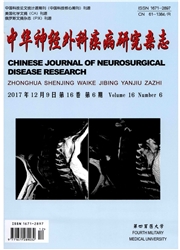

 中文摘要:
中文摘要:
目的研究开发诱导胶质母细胞瘤细胞凋亡的新型抗肿瘤药物并探讨其机制。方法以U87MG、原代培养的人源性胶质母细胞瘤株和SVGp12细胞为研究对象,采用甲基噻唑基四唑(MTF)法检测ardipusilloside Ⅰ作用后细胞的增殖活性,通过流式细胞仪分析细胞周期,Hoechst33342细胞核染色,透射电子显微镜观察ardipusillosideⅠ作用后细胞形态学的改变。Western blot检测细胞内FasL、Fas、caspase-8和caspase-3的蛋白表达情况。结果ArdipusillosideⅠ以时间和浓度依赖的方式显著抑制了人胶质母细胞瘤U87MG细胞和原代培养人源性胶质母细胞瘤细胞的增殖活性。随着时间的延长和浓度梯度的增加,处理组逐渐显示出典型的凋亡细胞形态学特征。ArdipusillosideⅠ明显地改变了胶质母细胞瘤的细胞周期。结论ArdipusillosideⅠ成功诱导了人脑胶质母细胞瘤U87MG细胞和原代培养的人源性胶质母细胞瘤细胞发生凋亡。
 英文摘要:
英文摘要:
Objective To study the effect of ardipusilloside Ⅰ on glioblastoma and examine its mechanism. Methods The effect of ardipusilloside Ⅰ on the viability of U87MG cells, primary cultured glioblastoma cells and SVGp12 astrocytes was assessed by the methyl thiazolyl tetrazolium (MTT) assay. Nuclear morphological changes of cells were detected by staining with Hoechst 33342. In addition, electron microscopy, cell cycle analysis and Western blot analysis were used in the study. Results In the study ardipusilloside Ⅰ substantially inhibited the proliferation of glioblastoma U87MG cells and primary cultured glioblastoma cells in a time- and concentration- dependent manner. Cellular changes of apoptotic cells were observed under inverted microscope. Hoechst staining of the nuclei revealed fragmented nuclei in treated cells. Ardipusilloside Ⅰ exposure also gradually increased the sub-G1 fraction (the apoptotic cell population) and produced an S phase-arrest of both glioblastoma cells. Furthermore, ardipusilloside Ⅰ increased the expression of Fas and its ligand (FasL), and enhanced the activation of caspase-8 and caspase-3. Conclusion The study confirms the induction of apoptosis by ardipusilloside Ⅰ in both glioblastoma U87MG cells and primary cultured glioblastoma cells.
 同期刊论文项目
同期刊论文项目
 同项目期刊论文
同项目期刊论文
 Resveratrol attenuates ischemic brain damage in the delayed phase after stroke and induces messenger
Resveratrol attenuates ischemic brain damage in the delayed phase after stroke and induces messenger 期刊信息
期刊信息
